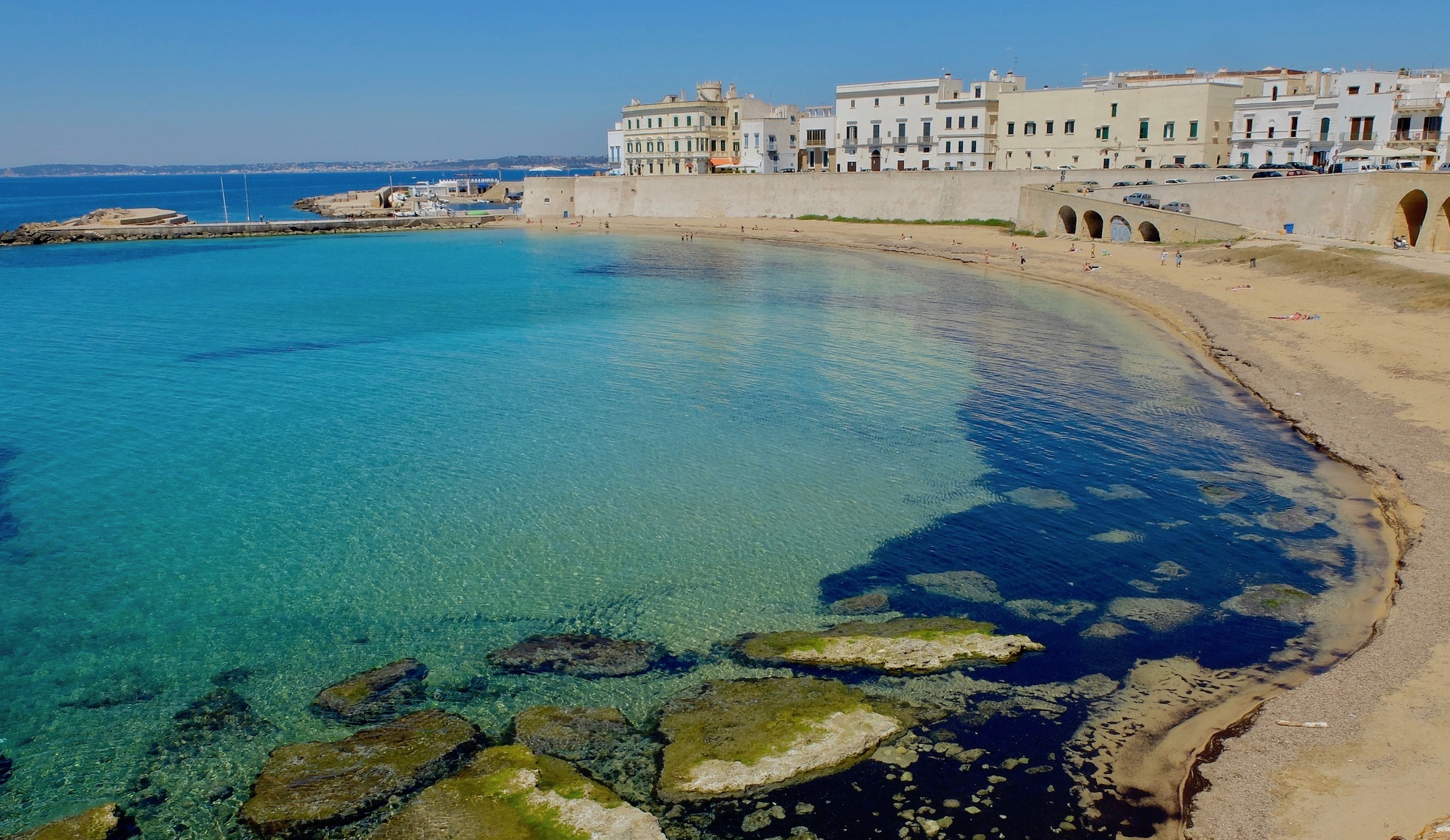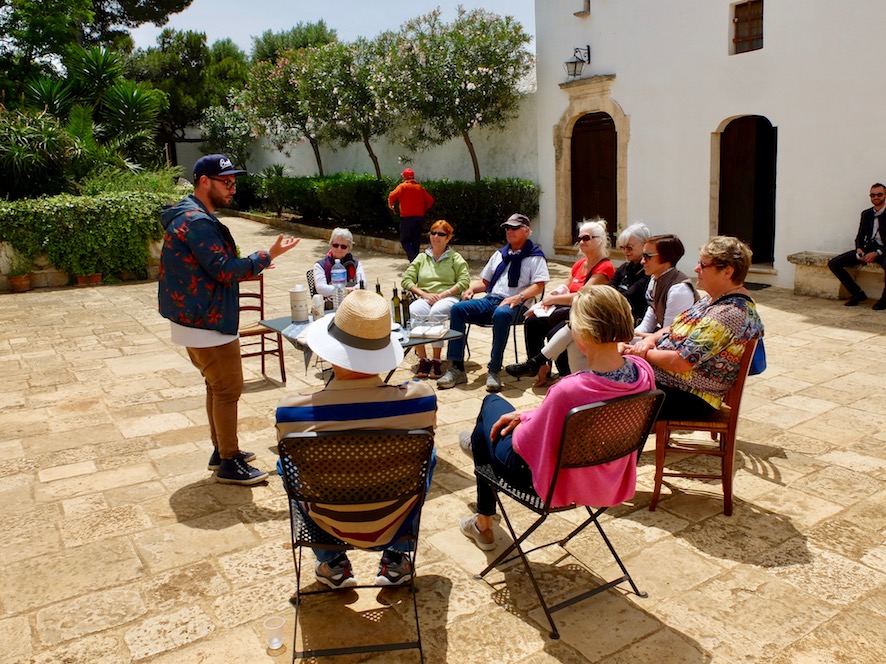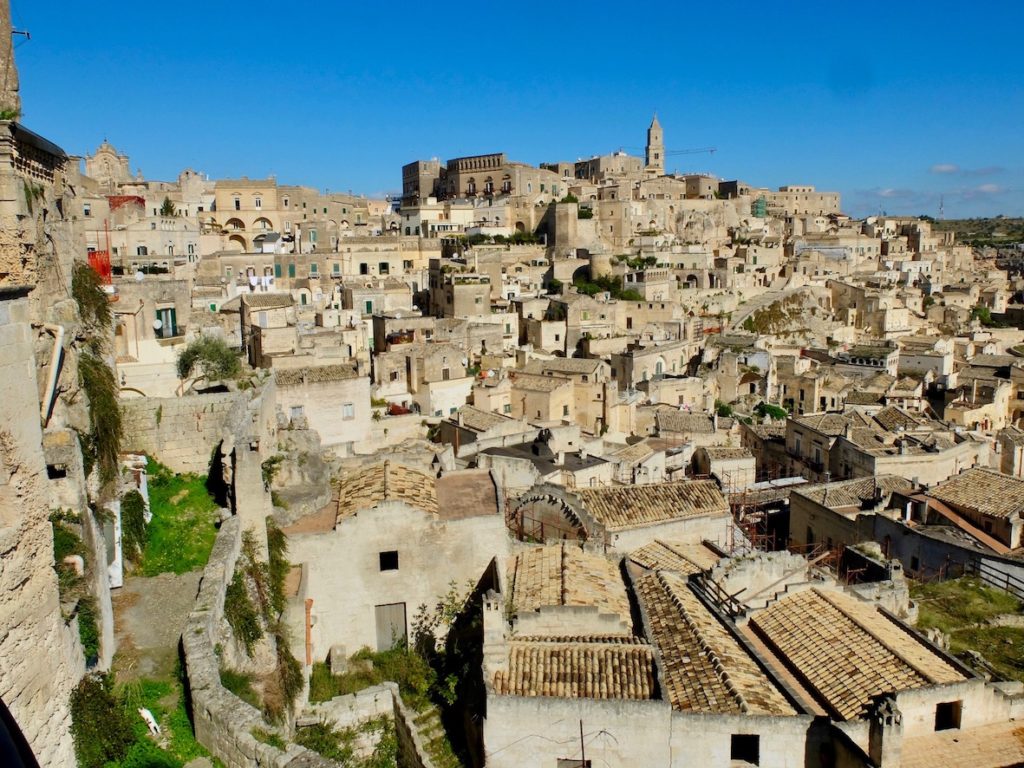
08 Jul UNDISCOVERED TREASURES OF PUGLIA – MAY 2017
What a wonderful and still undiscovered area Puglia is, and our May tour this year began in the most beautiful of Pugliese towns, Lecce. We spent our first, perfect day walking with our local guide Simona, a passionate Leccese who has the ability to bring to life the stories and characters of the city she loves so much.
One of the unusual stops we made was at a workshop where they construct and restore carta pesta, the Leccese version of papier-mâché. This construction method has always been used to make religious statues. It’s popular not only because there is no marble in the area but also because they are extremely light and can be carried through the streets for processions or mounted in churches without causing structural damage. Some are up to 400 years old and need constant care and restoration. Others are made new, including smaller models for personal use in people’s homes.
We could really visualise the layers of civilisation in the city when we visited a museum that began as a plumbing exercise. Attempting to fix leaky pipes, the building owners began to dig underground only to discover an archeological treasure trove just centimetres beneath their feet. While the actual artefacts have been surrendered to the authorities who oversee national treasures, the building is open for exploration and we were able to wander though the different layers of Leccese civilisation from the Messapians to the Greeks, Romans and beyond.
Our visit to Otranto, a town south of Lecce, introduced us to a small but famous walled seaport from which crusading knights departed for the Holy Land. We strolled the walls, admiring the blue bay and enjoying weather so clear that we could see as far as Albania on the other side of the Adriatic.
We were also lucky enough to see the Tree of Life, one of the largest early medieval mosaics in Europe that is still in place in the cathedral. It covers the entire floor of the cathedral and depicts the connections of all forms of creation, with creatures as the base and God at the apex and the immaculate state of humanity free from corruption and sin. Figures to the side illustrate ways of behaviour that will help a good person avoid falling into this sinful state, a lesson for us all!
We also stopped into Galatina, a small farming town to see an exquisite complete Renaissance fresco cycle depicting the life of St Catherine of Alexandria, not only beautiful but also unusual in that Renaissance art is rarely seen in this part of Italy. From the religious to the culinary, we called in to a pasticceria to sample pasticciotto, a uniquely local concoction of short pastry filled with custard that in Galatina is still produced by the seventh generation of the pastry cooks who invented it.
Finally we moved on to Gallipoli on the other side of the peninsula overlooking the Ionian Sea. This fishing port is a popular holiday destination for Italians seeking its lovely sandy beaches; two of our intrepid travellers took to the water for a quick dip. Seated along the sea wall, we dined on fresh local seafood before our return to Lecce.

After inspecting the olive trees and presses we had to taste the oil!
Leaving Lecce on our way into the Valle d’Itria we stopped at a masseria, one of the traditional fortified farmhouses that have now been restored and are used for wine production. Our charming hostess Alessia took us on a tour to learn about Puglian wines. We wandered through the vineyards, where a crew of local women from the village were pruning the vines, and learned about the masseria’s vine growing technique. The alberello technique dates back to Roman times and allows the vines to grow as small trees rather than on a trellis.
Alessia organised one of the local village ladies to come in to cook us a typical meal, simple but absolutely wonderful: we feasted on fresh fennel, homemade local ricotta, orecchiette with a light vegetable sauce and a delicious tart, all washed down with lashings of the masseria’s wine.
For the next four nights we stayed in a country retreat near Martina Franca, a beautifully restored farmhouse. The breakfast room is built within three trulli, the typical round white buildings with their conical slate roofs for which this area is famous. Alberobello is the centre of the trulli region and our visit there provided guests with some great photo opportunities. We were also fascinated to explore an abandoned trullo that our driver knew of and see how these now mostly restored buildings would have functioned in their original state.
We also visited an ancient olive grove, with one of the most ancient olive trees in Puglia that is believed to be somewhere between 2500 and 3000 years old and still bearing fruit. The owners took us through their underground olive presses where we could see a pre-Roman, a Roman and a medieval olive press that are still intact. We did of course try the oil from the ancient trees which was very good.
On one of our days here we drove down towards Taranto to visit the MARTA, an exceptional archeological museum housing an enormous collection of artefacts from the area. The collection goes as far back as the Bronze Age, and includes items from the area when it was occupied as a Spartan colony and later roman artefacts. There are fabulous grave goods including intricate gold jewellery of inestimable value, decorated Greek pottery, fine Roman glassware and an actual tomb of one of the athletes from the Olympic Games and his winnings: four huge urns of olive oil!

Looking down on the ravines in Matera
We headed towards our next base at Trani via Bari, where we stopped to explore the rabbit warren of the medieval centre with our local guide and to visit the Basilica of St Nicholas, where we mingled with the pilgrims who come from all over the world to visit his tomb. Although this is a Catholic Church, St Nicholas is revered by Greek, Russian and Romanian Orthodox Christians, who are encouraged to pray over his relics at least once during their lifetimes. Interestingly, to facilitate this the Catholic Pope had just sponsored the loan of one of his bones to the patriarch of the Russian Orthodox Church in Moscow.
Back on the coast in Trani and we stayed in a lovely hotel overlooking the fishing port; from the terrace we sipped aperitivi and watched the sun go down. What bliss!
The unquestionable highlight of this part of the trip was our visit to Matera, where for centuries people built their dwellings into the rock faces of the ravines. In fact, this city is the third oldest continually occupied urban space in the world. It was originally settled by pre-historic local tribes and remained inhabited until the 1950s, when a slum clearance program removed the inhabitants. Our guide Antonio grew up with grandparents who lived in one of these fascinating dwellings and shared his memories of life during that time. Today the Matera is undergoing a resurgence and the dwellings are now filled with boutique hotels, bars and shops, as well as some local residents who are returning to live there.
Our final base was on the Gargano peninsula in gorgeous accommodation overlooking the Bay of Mattinata, so called because it is bathed in morning sunlight. This is area of spectacular natural beauty, with limestone cliffs rising up from water so clear that you can see right to the bottom.
The land rises steeply from the coast to a cooler, greener agricultural landscape, with beautiful forests and cream Podolica cattle, wearing collars and bells around their necks. The pilgrim site of St Michael is located here in an underground cave that is entered through a church above. We descended the steep steps to the grotto beneath, sharing the moment with dozens of visiting pilgrims. Driving back down to the coast again, we finished the day at an old fishing outpost called a trabucco where we had dinner by the waterside as the sun set.
On the last day of the tour, we took a private boat trip along the coast looking at the limestone cliffs, chatting with local fishermen, exploring caves, and arriving finally at a pebbly beach where we had a private picnic lunch overlooking the symbols of Puglia, white limestone outcrops that form islands in the blue bay, the ‘faraglioni.’ We could not have asked for a more perfect way to end our tour.
Our September 2017 trip to Puglia is booked out, but we will be running the tour again in May 2018, so start planning your next holiday in Italy now!
14 – 28 May 2018 – click here for the full itinerary!
